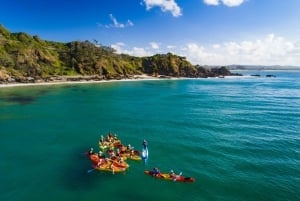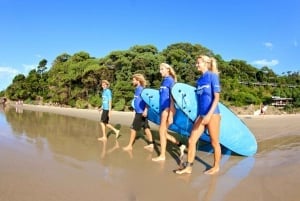Beach and Surf Safety
Our region is known for its beautiful beaches. There are endless opportunities for swimming, surfing, fishing and all manner of watersports. But with that comes risks and it's wise to follow certain safety guidelines. This is especially useful information for those travellers who are unfamiliar with the type of rugged surf beaches we have here on the NSW North Coast of Australia.
1. Swim between the flags
It is always safest to swim or surf at beaches that are patrolled by lifesavers or lifeguards.
Many NSW beaches are patrolled by volunteer surf lifesavers or professional lifeguards employed by the local council. Volunteers generally patrol popular beaches on weekends and public holidays. Professionals may work 5 days per week. Look for the distinctive red and yellow uniforms (or the professionals may be in long sleeved white shirts with blue collars and cuffs with the word LIFEGUARD in red).
If you require any help, need medical assistance, have a question or are in doubt about anything at a beach, just ask a lifeguard.
Swim between the red and yellow flags. These are the areas for swimming that are deemed safest and are patrolled by lifeguards.
Make sure you obey any other signs or instructions from lifeguards. Beach closed signs may be used where there are dangerous conditions or shark warnings. Shark alarms may also be sounded at patrolled beaches. If you do hear an alarm, exit the water immediately.
If you require help in the surf, stay calm (tread water if you can) and raise one hand up out of the water and wave.
2. Watch for rips
Rips are strong currents that run from beaches out to sea and can easily catch unsuspecting swimmers out.
You will often see surfers using the rips to get out the back quickly to catch their next wave. Look out for rippled or sand coloured water amongst the waves, a calmer or flatter surface in the midst of waves, or waves breaking further out from the rest as this could indicate a rip. If you get stuck in a rip and feel yourself being taken out to sea, do not panic or struggle and do not swim against the rip. Conserve your energy. The safest thing to do is go with the rip – then once it has taken you out beyond the waves you can then swim parallel to the beach, away from the rip channel. Once clear of the rip you can then swim back or catch waves into an area of the beach where there is no rip.
3. Avoid swimming at dawn, dusk, after heavy rain or where open rivers and waterways run into the sea
Much as we hate to think about it, there are sharks out there. You have more chance of being hit by a bus than being taken by a shark, but it's wise to take certain precautions to avoid a close encounter. Don't go swimming in murky waters where visibility is low. Always swim in groups and avoid areas where there is fishing activity or there are signs of baitfish in the water (diving sea birds is a good indicator of this).
If you do happen to spot a shark (or think you might have) tell a lifeguard immediately. If you are on a non-patrolled beach, let those around you in the water know.
4. Surf etiquette
If you are learning to surf make sure you keep well clear of swimmers and other surfers.
There are right of way rules when surfing, and you don’t want to drop in on another surfer (i.e. catch a wave which is theirs). The basic rule of thumb is that the person who catches the wave first (the person sitting closest to the shoulder, where the wave breaks) has the right of way.
5. General swim safety
Don't swim on a full stomach or under the influence of alcohol or drugs.
Always look before you enter water, as depths and conditions change, especially with sand movement.
Always wear sunscreen!












